Insect & Disease Conditions Update
A printer-friendly version of this report will be available on-line from the Conditions Report Index soon.
This is a
busy season for our division. Detection of emerald ash borer in the Madawaska/Frenchville
area of Aroostook County and recent retirements will present short-term
challenges requiring patience. Our preferred mode of reports is through the
on-line reporting form at the following web address: https://www.maine.gov/dacf/mfs/forest_health/tree_ailment.html. This is routed to our receptionist, who does
a great job sending requests on to the appropriate person. Second to that, you can call our main number
at the lab (207) 287-2431. We do also
welcome direct calls or e-mails.
If you have
a question about turf, garden, household or structural pests or ticks, please
contact the Pest Management Office at the University of Maine Cooperative
Extension https://extension.umaine.edu/ipm/ or (207) 581-3880.
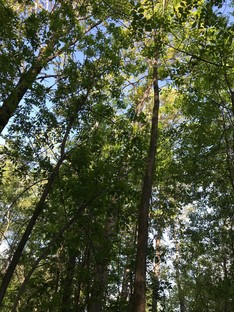 We knew it was a matter of ‘when’ not ‘if’
emerald ash borer (EAB) would be detected in Maine. The identification of a sample of EAB
collected in Madawaska, ME on May 22, was confirmed by the official USDA APHIS
identifier on May 28. A public meeting,
attended by more than 50 people, was held in the town of Frenchville on June 18
to receive input regarding a proposed order to stop movement of ash and
hardwood firewood from the towns of Frenchville and Madawaska. The order is
being drafted, and the Maine Forest Service is still seeking public input.
Photo: Brown ash (black ash, Fraxinus nigra) in an emerald ash
borer-infested stand in Madawaska.
In early stages of attack, trees show little outward sign of
damage. Photo: Maine Forest
Service, DACF.
The Maine Forest Service and our partners are in
the early stages of determining the extent of the infestation in the Madawaska
area. In initial surveys, the infestations appear light and cover an area of less
than one square mile. Infested trees have subtle clues of attack and one can
easily walk through an infested stand without seeing evidence of damage. Were it not for the detection of the more
intense infestation in Edmundston, the EAB in Madawaska/Frenchville would
likely have remained undetected for several more years. It may be quite some
time before we find infested trees in additional towns – however, given the
nature of this insect and survey, new detections could be found before you open
this bulletin.
Over the next several weeks, the
department will wrap up deployment of roughly 250 traps for possible early
detection of emerald ash borer populations in other Maine locations. In
addition, about a dozen trap trees were created in the area around
the Madawaska detection. The USDA APHIS
contractor, Delta 21, is deploying an additional 411 traps in the area within
100 miles of the quarantine in New Hampshire (DACF will not be hanging traps in
that area).
Even though this destructive
insect has been found in the state, it is still too early in most of Maine to
be treating specimen ash with pesticides to protect them. Experts recommend
holding off treatment until the EAB is within 10–15 miles of the trees in
question. In the meantime, resources are better spent on inventorying ash and
surveying and monitoring for the pest.
If you work with, own or rely on
ash (Fraxinus spp.), then you should
have some idea of how EAB will impact your life and work and some plan for
adapting to a future with fewer ash. If you have ash growing near important
infrastructure, such as buildings, driveways, town or city roads, public
recreation trails or parks, you should have an idea of what you will do when
the ash borer arrives, and consider whether you should remove and replace ash trees
proactively.
The need for awareness and a plan
is more urgent in areas that are closest to known infestations, but the
detection in Madawaska should drive home the message that anyone who has the
potential to suffer from the impacts of widespread mortality of ash should take
some serious steps towards planning. Some planning resources are already
available on the department website, www.maine.gov/eab; others will become available as
the website is updated.
|
Many reports received at our offices through the
months of May and June concerned caterpillars defoliating trees or causing
human discomfort and disgust. Prime offenders over were browntail moth, forest
tent and winter moth caterpillars.
Unfortunately, most people notice these after it is practical to
alleviate damage or discomfort from them.
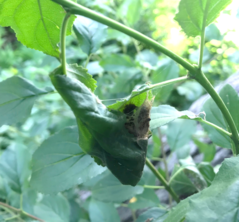 Browntail
moth is an invasive species from Europe that impacts
tree and human health. Most of the caterpillars have completed development for
this year, although some may still be wandering and the toxic hairs they shed will
be present for a longer time. The caterpillars pupate singly or communally in a
loose, hairy cocoon. Those cocoons are
full of the signature toxic hairs causing skin irritation and should be avoided
or removed with caution. Adults will emerge from the cocoons beginning in
Mid-July. To learn more about Browntail Moth, please visit our website.
Photo: Invasive browntail moth cocoon wrapped in invasive common buckthorn leaves beneath defoliated bur oak (Bangor, ME, June 20, 2018). Photo: Maine Forest Service, DACF.
|

Photo: Exposure to hairs from
browntail moth caterpillars can cause a painful, itchy rash or sometimes
more severe reaction. Photo used by
permission.
Browntail moth is capable of surviving in areas far beyond its current
distribution. People can most readily move this pest from when the caterpillars
are wandering from their webs through the end of adult flight in late-July (it
can also readily be moved on ornamental plants outside that window). We have
received reports of dozens of caterpillars on each tire of vehicles parked
under infested trees; have seen pupae in innumerable places, and know adults
can fly well, but also are transported by vehicles. If you travel regularly between browntail-infested
areas and those not infested, but sure to keep an eye out in those uninfested
areas for signs that you have unintentionally moved this caterpillar.
Unfortunately, with continued high populations of
browntail moth in heavily populated areas, expansion of the affected area will
continue and new, remote spots of infestation will develop. Addressing remote populations
through management may help slow the expansion of new populations.
|
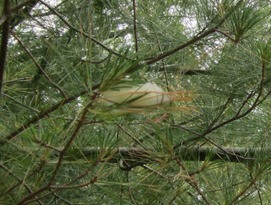 Forest
Tent Caterpillar is the only native in this group of three offenders.
It is hard to be grateful for this when thousands of caterpillars are pooping
all over you and your home, keeping you inside and causing traffic concerns as
they are spread across the pavement.
However, there should be some comfort in knowing that there will eventually
be relief from this when populations decrease and that the hairs left behind by
these caterpillars are not toxic. We have had reports of intense defoliation in
Blue Hill and Brooklin (Hancock County). Most of the wandering caterpillars
will pupate by Independence Day, giving residents and visitors to the affected
areas one more thing to celebrate. When the epidemic will subside is another question. This is the second year of recorded
defoliation in that area. Forest tent caterpillar epidemics often subside after
3–5 years of defoliation.
Photo: Forest tent caterpillar cocoon in eastern white pine, Blue Hill, ME.
Photo: Maine Forest Service.
Winter Moth is an invasive
caterpillar from Europe. The caterpillars have wrapped up feeding for the year
and pupate in cocoons in the soil beneath defoliated trees and shrubs. Those
pupae remain in the soil until adults emerge beginning in November. Movement of
soil and plantings from infested areas should be avoided.
Abatement of this pest may be on the horizon with continued work. Winter
moth was much harder to find in Massachusetts this year, where it had been
causing significant defoliation for around two decades. Soil-dwelling
predacious arthropods and the introduced parasitic fly, Cyzenis albicans, are given credit for winter moth decline in these
areas. The significant role of soil-dwelling predacious arthropods in the
control of winter moth is a strong argument for applying the least toxic lawn
care solutions – those that do not include broadcast use of broad-spectrum
insecticides. Regarding the parasitic fly, the Maine Forest Service continues
to release C. albicans when it is
available. This biocontrol program is funded by USDA and coordinated by the
Elkinton Lab at the University of Massachusetts, Amherst.
|
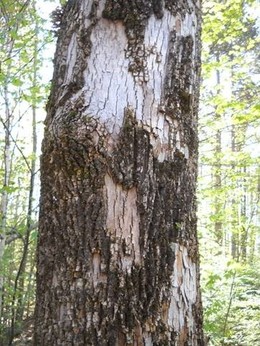
Smoothpatch affects several
species of hardwoods including Ash (Fraxinus spp.); birch (Betula spp.); basswood (Tilia
spp.); elm (Ulmus spp.); hickory (Carya spp.); hop-hornbeam (Ostrya
virginiana); hornbeam/musclewood (Carpinus caroliniana); maple (Acer
spp.); oak (Quercus spp.); willow (Salix spp.).
The symptoms can be caused by fungi in the following
genera: Aleurodiscus, Dendrothele and Hyphoderma. In Maine, Aleurodiscus is
most commonly seen on mature ash and oak trees.
Photo: Several areas of smooth patch on an ash tree in a forested setting. Photo: Dennis Dobson.
The fungi that cause smooth patch decompose the
outer corky bark of their hardwood hosts, leading to bark sloughing off,
leaving a conspicuous, often irregularly shaped smooth patches. Patches are
more noticeable, since they are typically lighter in color than uninfected
portions of bark. The patches vary widely in size and shape and can sometimes
cover large portions of the lower boles
of trees. Small (<1/4”) ear-shaped mushrooms can be seen on affected areas
of bark, but are often difficult to see, especially in dry conditions when
these spore-producing structures shrivel and become barely detectable. Symptoms
of this disorder are seen throughout the year.
The fungi that cause smooth patch only feed on
the mature corky bark of trees and do not have a negative impact of the health
of host trees. Thus, management is not recommended.
|

White pine
needle diseases (primarily
caused by Lecanosticta acicola, Lophophacidium dooksii and Bifusella linearis) – The yellowing, browning, and premature
shedding of one-year-old needles of white pines appears to be beginning in the region. Due to the wetter spring in 2017, symptoms
are predicted to be moderate to severe this year throughout the range of white
pine in Maine. White pine trees can be expected to exhibit needle yellowing
followed by needle drop any time between
now and early July. Trees that have been severely damaged over several
consecutive years may show dieback
of lower branches and an overall “thin” crown appearance. Weakened trees may be
subjected to additional damage from
secondary insects and pathogens that are better able to take advantage of
chronically stressed trees.
Photo: Symptoms of white pine
needle diseases. Photo: Isabel Munck, USDA Forest Service.
|
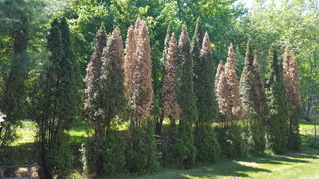
Winter injury of white cedar/arborvitae cultivars has been
reported in several locations in central Maine in late May and early June this
year. Symptoms have included foliage with a bleached appearance and varying
degrees of dieback in a top-down progression. In many cases the plantings were
between 15 and 20 years old and no sign of insect or disease agent was seen.
The bases of trees were free of damage and no indications of girdling roots
were seen (both of which can also be responsible for similar symptoms). It is
believed that the damage may be associated with fine root dieback due to
drought and/or freeze injury or the unusual warm-up periods experienced during
the winter months. Trees in protected areas did not seem to be affected, giving
further indication of the disorder’s relation to adverse environmental
conditions. Trees with more than 50% crown dieback should be considered for
removal. Stressed/ damaged trees can attract or become more susceptible to secondary agents like pathogenic fungi and bark beetles. Further, the loss of 50% of the living crown likely has severe impacts on the aesthetic quality of affected shrubs that are often chosen for their pleasant appearance in landscape plantings.
Photo: Arborvitae top damage symptoms thought to be due
to winter injury. Photo: Deborah Keene.
|
Office hours are 7:30 a.m. to 4:00 p.m., Monday through
Friday, except for holidays. If you plan to visit either office, you may wish
to call ahead just to make sure someone will be present to meet with you. (207)
287-2431 (Augusta) and 827-1813 (Old Town)
Conditions
Report No. 2, 2018
On-line:
http://maine.gov/dacf/mfs/publications/condition_reports.html
Department of Agriculture Conservation & Forestry
Maine
Forest Service - Forest Health and Monitoring
Contributors:
Aaron Bergdahl, Allison Kanoti and Colleen Teerling
|